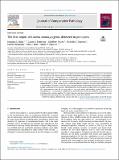Files in this item
The first report of Listeria monocytogenes detected in pinnipeds
Item metadata
| dc.contributor.author | Baily, Johanna L. | |
| dc.contributor.author | Paterson, Gavin K. | |
| dc.contributor.author | Foster, Geoffrey | |
| dc.contributor.author | Davison, Nicholas J. | |
| dc.contributor.author | Begeman, Lineke | |
| dc.contributor.author | Hall, Ailsa J. | |
| dc.contributor.author | Dagleish, Mark P. | |
| dc.date.accessioned | 2024-01-23T10:30:10Z | |
| dc.date.available | 2024-01-23T10:30:10Z | |
| dc.date.issued | 2024-01 | |
| dc.identifier | 298433944 | |
| dc.identifier | c7589036-e310-4384-a646-0f58ac518931 | |
| dc.identifier | 85182012255 | |
| dc.identifier.citation | Baily , J L , Paterson , G K , Foster , G , Davison , N J , Begeman , L , Hall , A J & Dagleish , M P 2024 , ' The first report of Listeria monocytogenes detected in pinnipeds ' , Journal of Comparative Pathology , vol. 208 , pp. 54-60 . https://doi.org/10.1016/j.jcpa.2023.12.003 | en |
| dc.identifier.issn | 0021-9975 | |
| dc.identifier.other | RIS: urn:884694D3D3062C304372ED317D888192 | |
| dc.identifier.other | ORCID: /0000-0002-7562-1771/work/151761220 | |
| dc.identifier.uri | https://hdl.handle.net/10023/29059 | |
| dc.description | This work and JLB's PhD studentship were funded by the Moredun Research Institute and the Royal Zoological Society of Scotland. The necropsy of the grey seal from Carnoustie, Angus, was funded by Marine Scotland, a division of the Scottish Government. Genome sequencing was provided by MicrobesNG (http://www.microbesng.com), which is supported by the UK Biotechnology and Biological Sciences Research Council (grant number BB/L024209/1). | en |
| dc.description.abstract | The aim of this study was to describe the pathology in seals from which Listeria monocytogenes was isolated and investigate if the lesions’ nature and severity were related to the phylogeny of isolates. L. monocytogenes was isolated from 13 of 50 (26%) dead grey seal (Halichoerus grypus) pups, six (12%) in systemic distribution, on the Isle of May, Scotland. Similar fatal L. monocytogenes-associated infections were found in a grey seal pup from Carnoustie, Scotland, and a juvenile harbour seal (Phoca vitulina) in the Netherlands. Whole genome sequencing of 15 of the L. monocytogenes isolates identified 13 multilocus sequence types belonging to the L. monocytogenes lineages I and II, but with scant phenotypic and genotypic antimicrobial resistance and limited variation in virulence factors. The phylogenetic diversity present suggests there are multiple sources of L. monocytogenes, even for seal pups born in the same colony and breeding season. This is the first description of L. monocytogenes isolated from, and detected in lesions in, pinnipeds and indicates that infection can be systemic and fatal. Therefore, listeriosis may be an emerging or overlooked disease in seals with infection originating from contamination of the marine environment. | |
| dc.format.extent | 7 | |
| dc.format.extent | 2394871 | |
| dc.language.iso | eng | |
| dc.relation.ispartof | Journal of Comparative Pathology | en |
| dc.subject | Bacterial genome sequencing | en |
| dc.subject | Neonatal mortality | en |
| dc.subject | Seals | en |
| dc.subject | Septicaemia | en |
| dc.subject | QH301 Biology | en |
| dc.subject | DAS | en |
| dc.subject | SDG 3 - Good Health and Well-being | en |
| dc.subject | SDG 14 - Life Below Water | en |
| dc.subject.lcc | QH301 | en |
| dc.title | The first report of Listeria monocytogenes detected in pinnipeds | en |
| dc.type | Journal article | en |
| dc.contributor.institution | University of St Andrews. School of Biology | en |
| dc.contributor.institution | University of St Andrews. Sea Mammal Research Unit | en |
| dc.contributor.institution | University of St Andrews. Scottish Oceans Institute | en |
| dc.contributor.institution | University of St Andrews. Marine Alliance for Science & Technology Scotland | en |
| dc.identifier.doi | https://doi.org/10.1016/j.jcpa.2023.12.003 | |
| dc.description.status | Peer reviewed | en |
This item appears in the following Collection(s)
Items in the St Andrews Research Repository are protected by copyright, with all rights reserved, unless otherwise indicated.

